
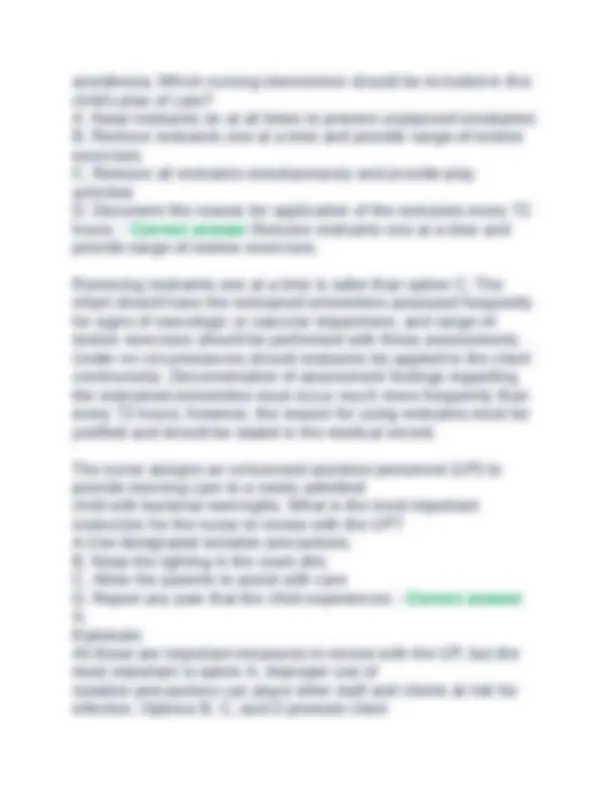
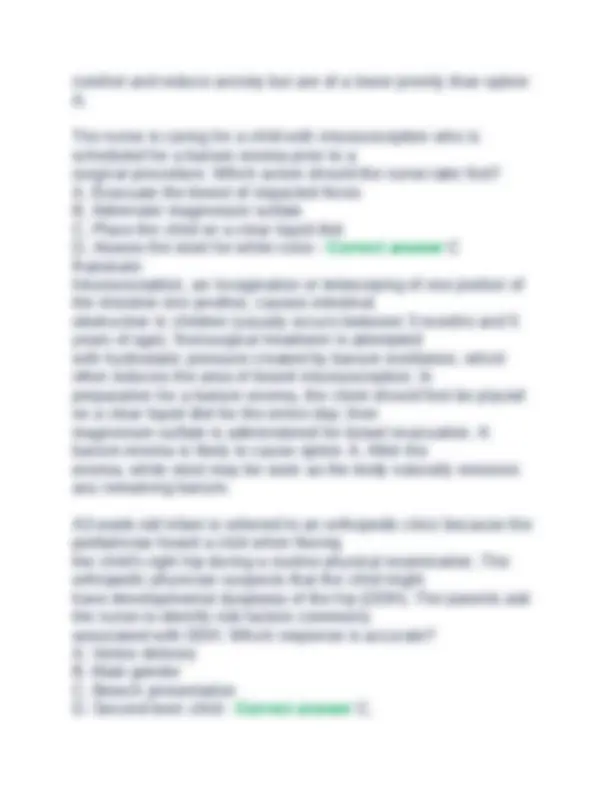
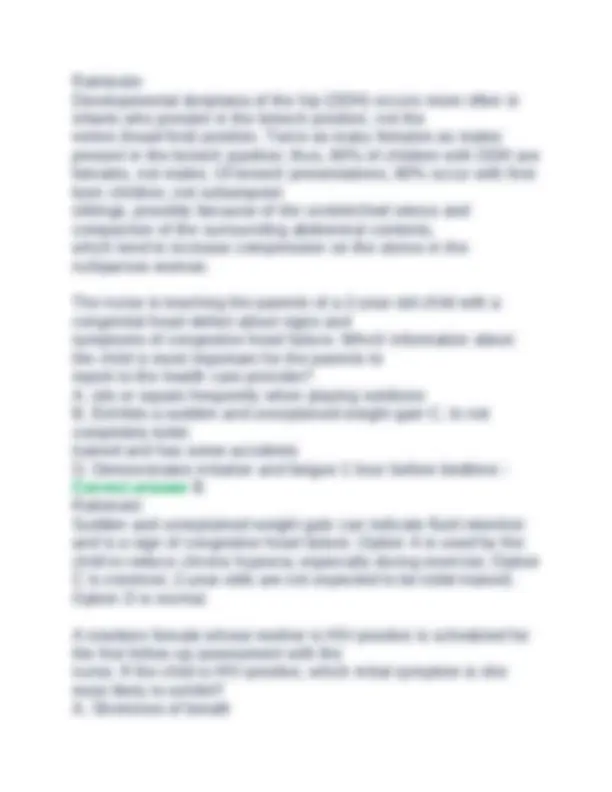
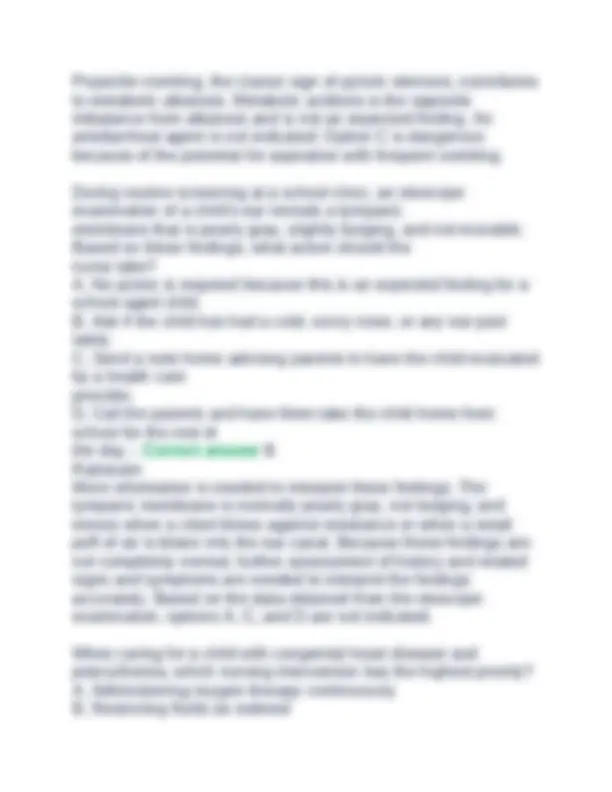
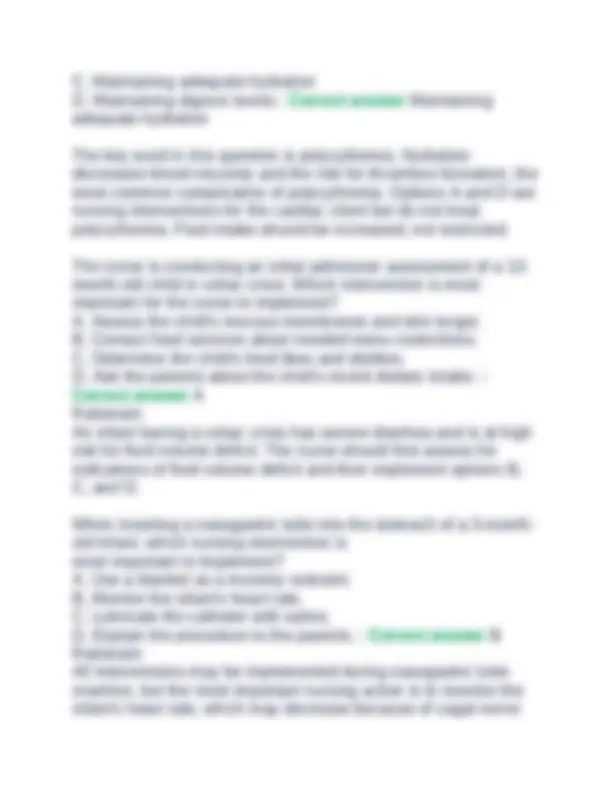
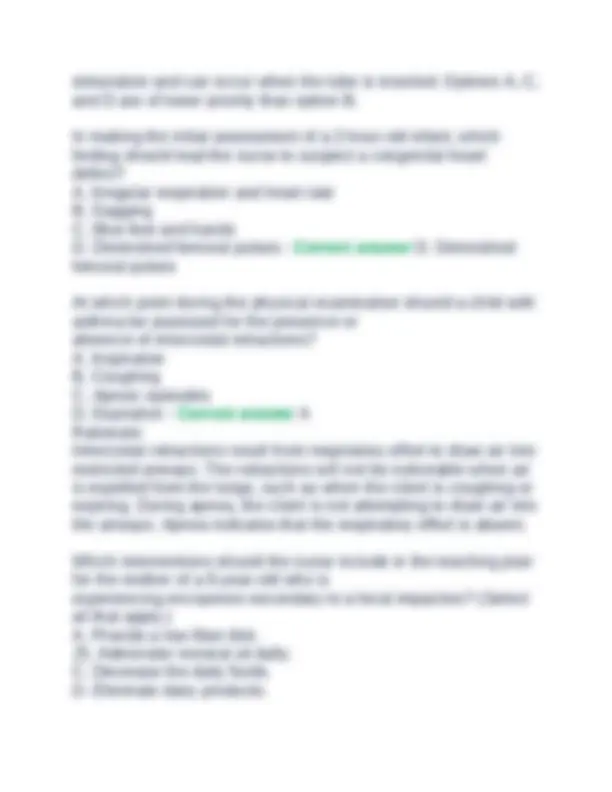
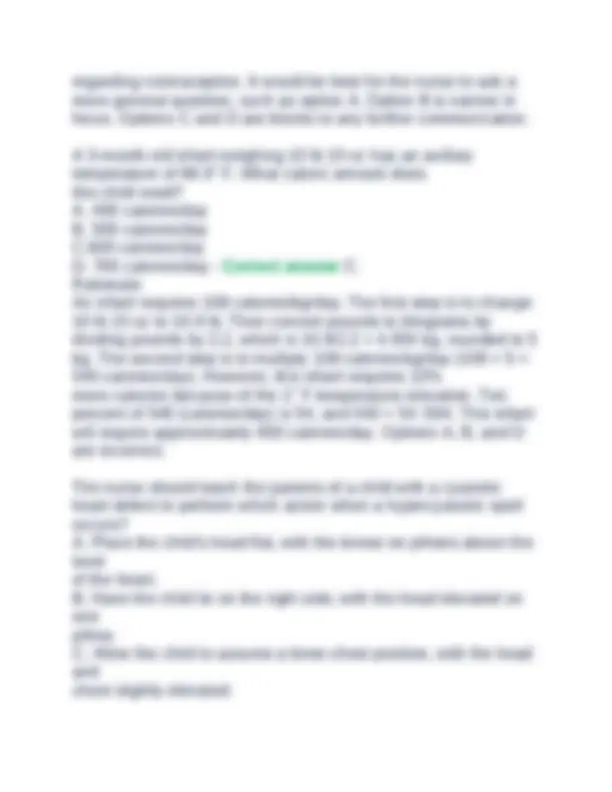
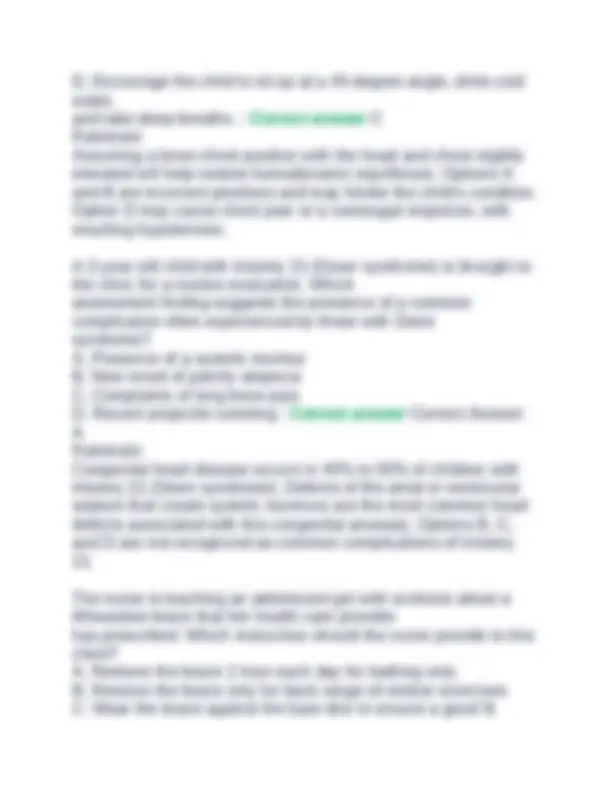
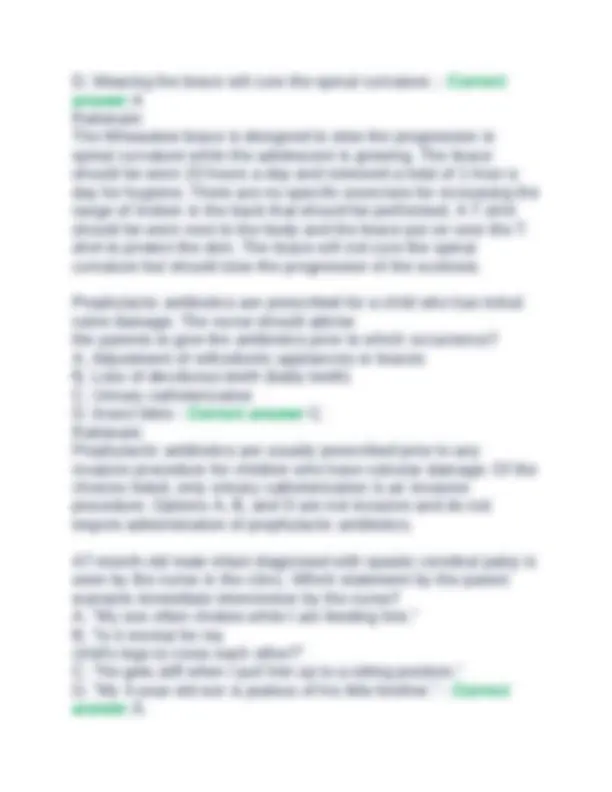
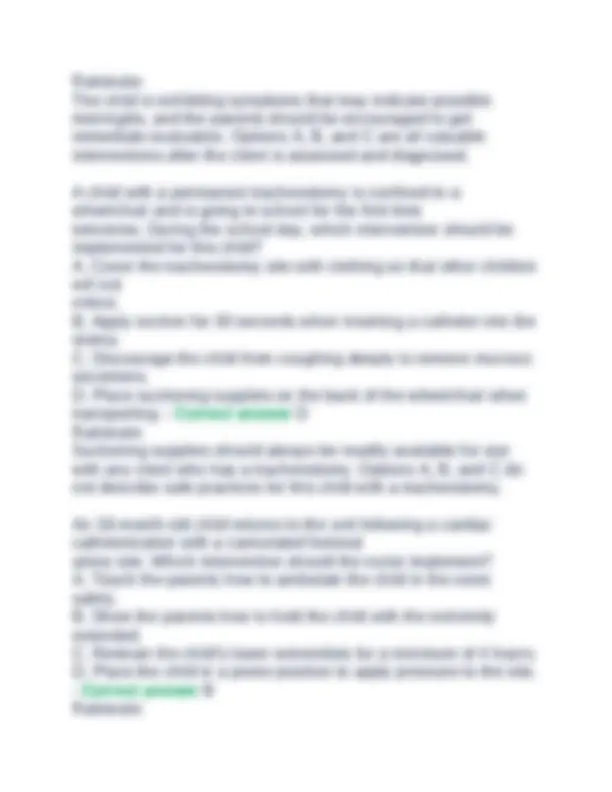
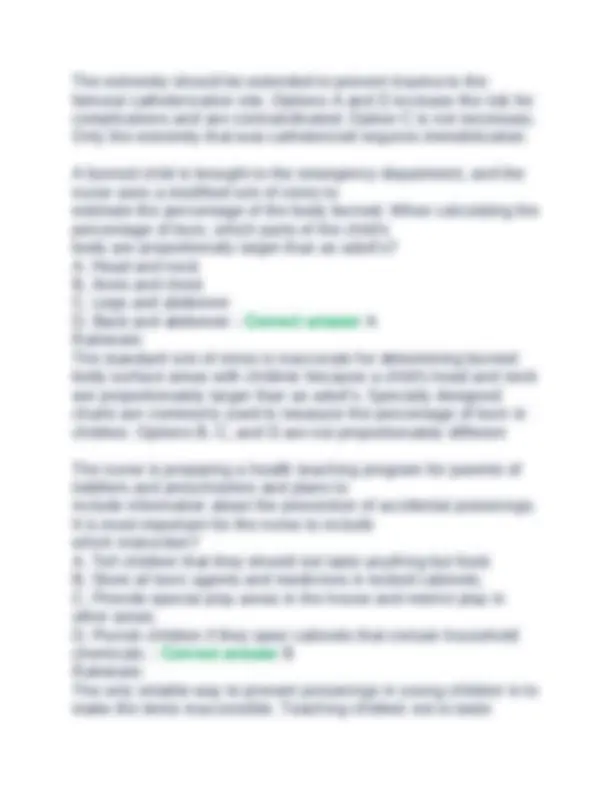

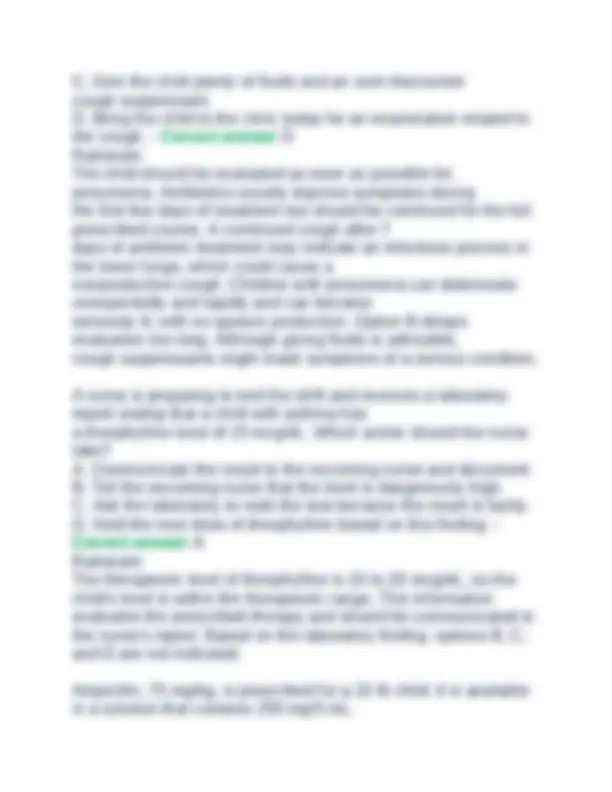
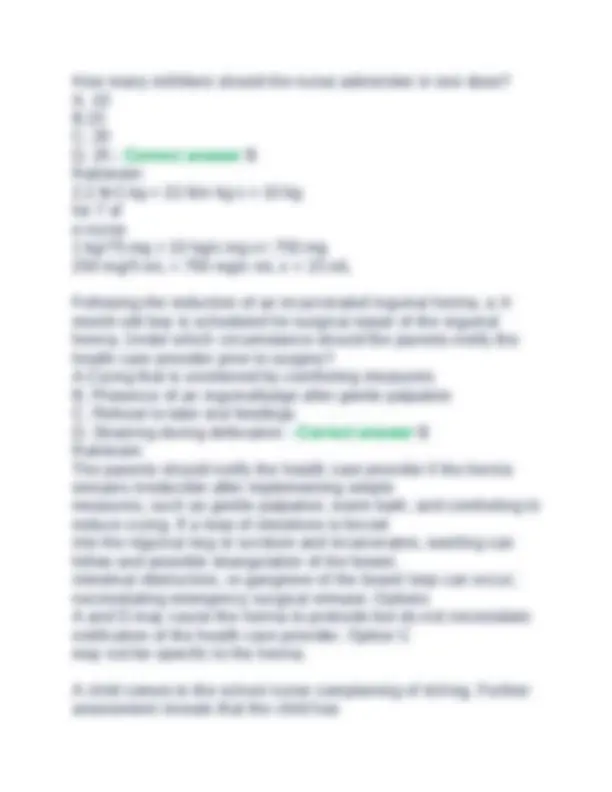
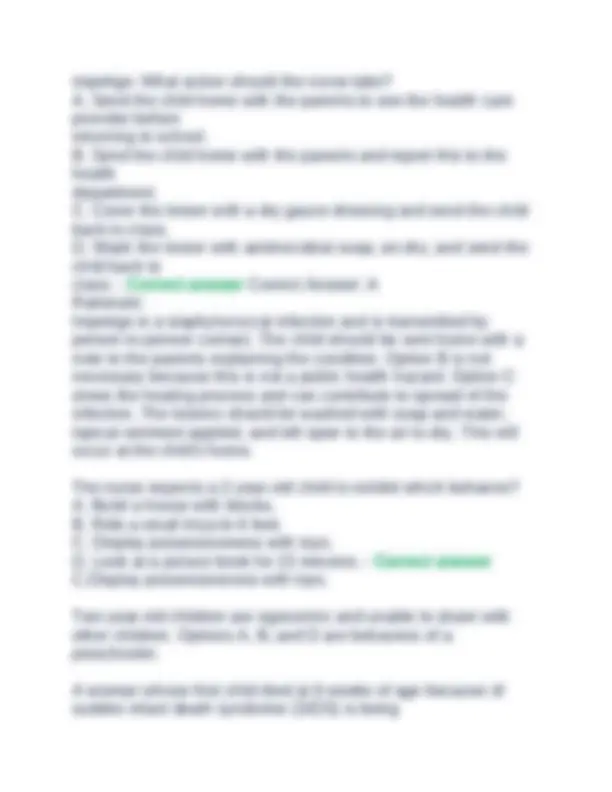
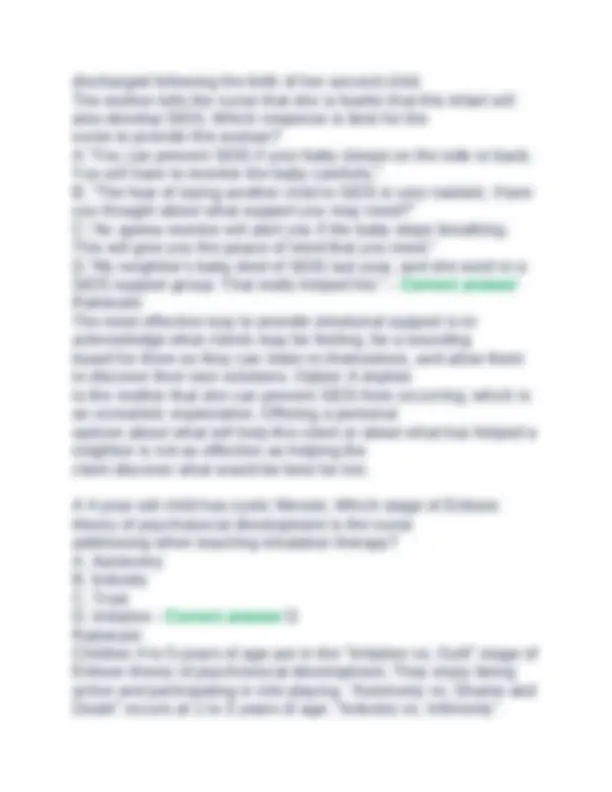
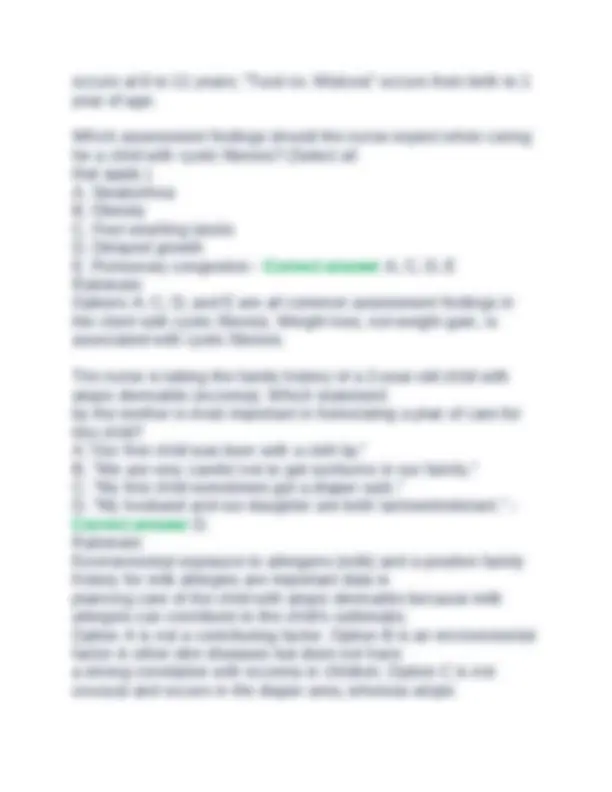



Study with the several resources on Docsity

Earn points by helping other students or get them with a premium plan


Prepare for your exams
Study with the several resources on Docsity

Earn points to download
Earn points by helping other students or get them with a premium plan
Community
Ask the community for help and clear up your study doubts
Discover the best universities in your country according to Docsity users
Free resources
Download our free guides on studying techniques, anxiety management strategies, and thesis advice from Docsity tutors
• HESI RN PEDIATRICS V2 REVISION • HESI RN PEDIATRICS V2 REVISION.
Typology: Exams
1 / 26

This page cannot be seen from the preview
Don't miss anything!



















1.The nurse is planning postoperative care for a child who has had a cleft lip repair. What is the most important reason to minimize this child's crying during the recovery period? A. Tear formation increases salivation. B. This behavior increases respirations. C. Excessive hysteria can lead to vomiting. D. Crying stresses the suture line - Correct answer Rationale: choice D Prevention of stress on the lip suture line is essential for optimum healing and the cosmetic appearance of a cleft lip repair. Although crying also causes options A, B, and C, these conditions do not create a problem for the child with a cleft lip repair. An infant is receiving digoxin for congestive heart failure. The apical heart rate is assessed at 80 beats/min. What intervention should the nurse implement? A. Call for a portable chest radiograph. B. Obtain a therapeutic drug level. C. Reassess the heart rate in 30 minutes. D. Administer digoxin immune Fab stat. - Correct answer Rationale: Answer: D. Sinus bradycardia (heart rate <90 to 110 beats/min in an infant) is an indication of digoxin toxicity, so assessment of the client's digoxin level has the highest priority. Option A is not indicated at this time. Option C provides helpful assessment data but does not address the cause of the problem and delays needed intervention. Option D
is indicated for a serious, life-threatening overdose with digoxin. The nurse admits a child to the intensive care unit with a possible diagnosis of Wilms tumor - What is the most safety precaution for child? A. maintain NPO status B. Limit visitors to the immediate family C. Place a do not palpate abdomen sign on head of bed d encourage ambulatory in pre operative period - Correct answer C. Protect child from injury; place a sign on bed stating "no abdominal palpation" (to prevent accidental fragmentation and dislodging into the abdominal cavity). The other option choices are not relevant at this time. The nurse is preparing a teaching plan for the mother of a child who has been diagnosed with celiac disease. Choosing which lunch will be within the therapeutic management of a child with celiac disease? A. Turkey salad, milk, and oatmeal cookies B. Baked chicken, coleslaw, soda, and frozen fruit dessert C. Tuna salad sandwich on whole wheat bread, milk, and ice cream D. Turkey sandwich on rye bread, orange juice, and fresh fruit - Correct answer Correct Answer: B Rationale: A child with celiac disease is managed on a gluten-free diet, which eliminates food products containing oats, wheat, rye, or barley. A 6-month-old male infant is admitted to the postanesthesia care unit with elbow restraints in place. He has an endotracheal tube and is ventilator-dependent but will be extubated soon following recovery from
comfort and reduce anxiety but are of a lower priority than option A. The nurse is caring for a child with intussusception who is scheduled for a barium enema prior to a surgical procedure. Which action should the nurse take first? A. Evacuate the bowel of impacted feces B. Admnister magnesium sulfate C. Place the child on a clear liquid diet D. Assess the stool for white color - Correct answer C Rationale: Intussusception, an invagination or telescoping of one portion of the intestine into another, causes intestinal obstruction in children (usually occurs between 3 months and 5 years of age). Nonsurgical treatment is attempted with hydrostatic pressure created by barium instillation, which often reduces the area of bowel intussusception. In preparation for a barium enema, the client should first be placed on a clear liquid diet for the entire day: then magnesium sulfate is administered for bowel evacuation. A barium enema is likely to cause option A. After the enema, white stool may be seen as the body naturally removes any remaining barium. A3-week-old infant is referred to an orthopedic clinic because the pediatrician heard a click when flexing the child's right hip during a routine physical examination. The orthopedic physician suspects that the child might have developmental dysplasia of the hip (DDH). The parents ask the nurse to identify risk factors commonly associated with DDH. Which response is accurate? A. Vertex delivery B. Male gender C. Breech presentation D. Second-born child - Correct answer C.
Rationale: Developmental dysplasia of the hip (DDH) occurs more often in infants who present in the breech position, not the vertex (head-first) position. Twice as many females as males present in the breech pasition; thus, 80% of children with DDH are females, not males. Of breech presentations, 60% occur with first- born children, not subsequent siblings, possibly because of the unstretched uterus and compaction of the surrounding abdominal contents, which tend to increase compression on the uterus in the nulliparous woman. The nurse is teaching the parents of a 2-year-old child with a congenital heart defect about signs and symptoms of congestive heart failure. Which information about the child is most important for the parents to report to the health care provider? A. sits or squats frequently when playing outdoors B. Exhibits a sudden and unexplained weight gain C. Is not completely toilet- trained and has some accidents D. Demonstrates irritation and fatigue 1 hour before bedtime - Correct answer B Rationale: Sudden and unexplained weight gain can indicate fluid retention and is a sign of congestive heart failure. Option A is used by the child to reduce chronic hypoxia, especially during exercise. Option C is common; 2-year-olds are not expected to be toilet-trained. Option D is normal. A newborn female whose mother is HIV-positive is scheduled for the first follow-up assessment with the nurse. If the child is HIV-positive, which initial symptom is she most likely to exhibit? A. Shortness of breath
C. Place the child in strict isolation to prevent an outbreak on the unit. D. Determine which staff have had varicella before making assignments. - Correct answer Rationale: The period of communicability of varicella is 2 days before the rash appears until all lesions are crusted; varicella is spread by direct or indirect contact of saliva or vesicles. Strict isolation is indicated to prevent further exposure to staff and others. Staff who have had varicella or the vaccine are not susceptible to contracting or spreading the virus and should be the only personnel assigned to care for this client. Option A is not sufficient to prevent exposure to others. Option B must be done prior to exposure. The nurse observes a 4-year-old boy in a day care setting. Which behavior should the nurse expect this Child to exhibit? A. Throws a temper tantrum when told he must share the toys. B. Plays by himself for most of the day. C. Boasts aggressively when telling a story. D. Cries and is fearful when separated from his parents. - Correct answer Rationale: Four-year-old children are aggressive in their behavior and enjoy telling tales. Options A and D are typical toddler behaviors. A preschooler's play is usually cooperative, so playing alone is not typical. Which preoperative nursing intervention should be included in the plan of care for an infant with pyloric stenosis? A. Monitor for signs of metabolic acidosis. B. Estimate the quantity of diarrhea stools. C. Place in a supine position after feeding. D. Observe for projectile vomiting. - Correct answer D Rationale:
Projectile vomiting, the classic sign of pyloric stenosis, contributes to metabolic alkalosis. Metabolic acidosis is the opposite imbalance from alkalosis and is not an expected finding. An antidiarrheal agent is not indicated. Option C is dangerous because of the potential for aspiration with frequent vomiting. During routine screening at a school clinic, an otoscope examination of a child's ear reveals a tympanic membrane that is pearly gray, slightly bulging, and not movable. Based on these findings, what action should the nurse take? A. No action is required because this is an expected finding for a school-aged child. B. Ask if the child has had a cold, runny nose, or any ear pain lately. C. Send a note home advising parents to have the child evaluated by a health care provider. D. Call the parents and have them take the child home from school for the rest of the day. - Correct answer B Rationale: More information is needed to interpret these findings. The tympanic membrane is normally pearly gray, not bulging, and moves when a client blows against resistance or when a small puff of air is blown into the ear canal. Because these findings are not completely normal, further assessment of history and related signs and symptoms are needed to interpret the findings accurately. Based on the data obtained from the otoscope examination, options A, C, and D are not indicated. When caring for a child with congenital heart disease and polycythemia, which nursing intervention has the highest priority? A. Administering oxygen therapy continuously B. Restricting fluids as ordered
stimulation and can occur when the tube is inserted. Options A, C, and D are of lower priority than option B. In making the initial assessment of a 2-hour-old infant, which finding should lead the nurse to suspect a congenital heart defect? A. Irregular respiration and heart rate B. Gagging C. Blue feet and hands D. Diminished femoral pulses - Correct answer D. Diminished femoral pulses At which point during the physical examination should a child with asthma be assessed for the presence or absence of intercostal retractions? A. Inspiration B. Coughing C. Apneic episodes D. Expiration - Correct answer A Rationale: Intercostal retractions result from respiratory effort to draw air into restricted airways. The retractions will not be noticeable when air is expelled from the lungs, such as when the client is coughing or expiring. During apnea, the client is not attempting to draw air into the airways. Apnea indicates that the respiratory effort is absent. Which interventions should the nurse include in the teaching plan for the mother of a 6-year-old who is experiencing encopresis secondary to a fecal impaction? (Select all that apply.) A. Provide a low-fiber diet. J5. Administer mineral oil dally. C. Decrease the daily fluids. D. Eliminate dairy products.
E. Initiate consistent tolleting routine. - Correct answer Encopresis is fecal incontinence, usually as the result of recurring fecal impaction and an enlarged rectum caused by chronic constipation. Encopresis is managed through bowel retraining with mineral oil, eliminating dairy products, and initiating a regular toileting routine. A high-fiber diet, not option A, and increased daily fluids, not option C, are components of care for a child with encopresis. The nurse is examining a male child experiencing an exacerbation of juvenile rheumatoid arthritis (JRA) and notes that his mobility is greatly reduced. What is the most likely cause of the child's impaired mobility? A. Pathologic fractures B. Poor alignment of joints C. Dyspnea on exertion D. Joint inflammation - Correct answer D Rationale: Joint inflammation and pain are the typical manifestations of an exacerbation of JRA. Options A, B, and C are not specifically related to JRA. A 3-month-old infant returns from surgery with elbow restraints and a Logan bow over a cleft lip suture line. Which intervention should the nurse implement to maintain suture line integrity during the initial postoperative period? A. Place the infant upright in an infant seat position. B. Provide mittens with the use of elbow restraints. C. Use soft rubber catheters for nasal suctioning. D. Apply water-soluble lubricant to the suture line - Correct answer A Rationale: The use of an infant seat simulates a supine position with the head elevated and also prevents aspiration. Prone positioning
regarding contraception. It would be best for the nurse to ask a more general question, such as option A. Option B is narrow in focus. Options C and D are blocks to any further communication. A 3-month-old infant weighing 10 lb 15 oz has an axillary temperature of 98.9° F. What caloric amount does this child need? A. 400 calories/day B. 500 calories/day C.600 calories/day D. 700 calories/day - Correct answer C. Rationale: An infant requires 108 calories/kg/day. The first step is to change 10 lb 15 oz to 10.9 lb. Then convert pounds to kilograms by dividing pounds by 2.2, which is 10.9/2.2 = 4.954 kg, rounded to 5 kg. The second step is to multiply 108 calories/kg/day (108 × 5 = 540 calories/day). However, this infant requires 10% more calories because of the 1° F temperature elevation. Ten percent of 540 (calories/day) is 54, and 540 + 54 :594. This infant will require approximately 600 calories/day. Options A, B, and D are incorrect. The nurse should teach the parents of a child with a cyanotic heart defect to perform which action when a hypercyanotic spell occurs? A. Place the child's head flat, with the knees on pillows above the level of the heart. B. Have the child lie on the right side, with the head elevated on one pillow. C. Allow the child to assume a knee-chest position, with the head and chest slightly elevated.
D. Encourage the child to sit up at a 45-degree angle, drink cold water, and take deep breaths. - Correct answer C Rationale: Assuming a knee-chest position with the head and chest slightly elevated will help restore hemodynamic equilibrium. Options A and B are incorrect positions and may hinder the child's condition. Option D may cause chest pain or a vasovagal response, with resulting hypotension. A 2-year-old child with trisomy 21 (Down syndrome) is brought to the clinic for a routine evaluation. Which assessment finding suggests the presence of a common complication often experienced by those with Down syndrome? A. Presence of a systolic murmur B. New onset of patchy alopecia C. Complaints of long bone pain D. Recent projectile vomiting - Correct answer Correct Answer: A Rationale: Congenital heart disease occurs in 40% to 50% of children with trisomy 21 (Down syndrome). Defects of the atrial or ventricular septum that create systolic murmurs are the most common heart defects associated with this congenital anomaly. Options B, C, and D are not recognized as common complications of trisomy
The nurse is teaching an adolescent girl with scoliosis about a Milwaukee brace that her health care provider has prescribed. Which instruction should the nurse provide to this client? A. Remove the brace 1 hour each day for bathing only. B. Remove the brace only for back range-of-motion exercises C. Wear the brace against the bare skin to ensure a good fit
Rationale: Airway obstruction is always a priority when caring for any client. Options B and C are characteristics of spastic cerebral palsy and may involve one or both sides. These children have difficulty with fine motor skills, and attempts at motion increase abnormal postures. Option D is an expected behavior and may need to be addressed, but it is not a priority over choking. Which nursing diagnosis has the highest priority when planning care for an infant with eczema? A. High risk for altered parenting related to feelings of inadequacy B. Altered comfort (pruritus) related to vesicular skin eruptions C. Altered health maintenance related to knowledge deficit of treatment D. Risk for impaired skin integrity related to eczema - Correct answer B Rationale: Altered comfort (pruritus) has the highest priority because itching will cause the infant to scratch, creating complications such as scarring or infection. Options A, C, and D are all important nursing diagnoses and should be considered when developing the infant's plan of care, but they do not have the priority of option B. The nurse notes that a 16-year-old male client is refusing visits from his classmates. Further assessment reveals that he is concerned about his edematous facial features. Based on these assessment findings, the nurse should plan interventions related to which nursing diagnosis? A. Social isolation B. Altered health maintenance C. Knowledge deficit D. Ineffective coping - Correct answer A Rationale:
Peer acceptance and body image are significant issues in the growth and development of adolescents. Option A addresses the problem of a lack of contact with peers stemming from his desire to protect his ego. Options B, C, and D are not supported by the assessment finding. A child is admitted to the hospital for confirmation of a diagnosis of acute lymphoblastic leukemia. During the initial nursing assessment, which symptoms will this child most likely exhibit? A. Bone pain, pallor B. Weakness, tremors C. Nystagmus, anorexia D. Fever, abdominal distention - Correct answer A Rationale: Option A lists the most common presenting symptoms of leukemia. Leukemic cells invade the bone marrow, gradually causing a weakening of the bone and a tendency toward pathologic fractures. As leukemic cells invade the periosteum, increasing pressure causes severe pain and anemia results from decreased erythrocytes, causing pallor. Options B and C could be associated with central nervous system disorders. Option D commonly occurs in children but is not specific for leukemia. A father of a 5-year-old boy calls the nurse to report that his son, who has had an upper respiratory infection, is complaining of a headache, and his temperature has increased to 103° F, taken rectally. Which intervention has the highest priority? A. Determine if the child has any allergies to antibiotics. B. Instruct the parent to give the child tepid baths. C. Instruct the parent to increase the child's fluid intake. D. Tell the parent to take the child to the emergency department. - Correct answer D
The extremity should be extended to prevent trauma to the femoral catheterization site. Options A and D increase the risk for complications and are contraindicated. Option C is not necessary. Only the extremity that was catheterized requires immobilization. A burned child is brought to the emergency department, and the nurse uses a modified rule of nines to estimate the percentage of the body burned. When calculating the percentage of burn, which parts of the child's body are proportionally larger than an adult's? A. Head and neck B. Arms and chest C. Legs and abdomen D. Back and abdomen - Correct answer A Rationale: The standard rule of nines is inaccurate for determining burned body surface areas with children because a child's head and neck are proportionately larger than an adult's. Specially designed charts are commonly used to measure the percentage of burn in children. Options B, C, and D are not proportionately different The nurse is preparing a health teaching program for parents of toddlers and preschoolers and plans to include information about the prevention of accidental poisonings. It is most important for the nurse to include which instruction? A. Tell children that they should not taste anything but food. B. Store all toxic agents and medicines in locked cabinets. C. Provide special play areas in the house and restrict play in other areas. D. Punish children if they open cabinets that contain household chemicals. - Correct answer B Rationale: The only reliable way to prevent poisonings in young children is to make the items inaccessible. Teaching children not to taste
anything but food is important but ineffective for young children. Options C and D will not control a child's curiosity. Which nursing interventions are therapeutic when caring for a hospitalized toddler? (Select all that apply) A. Require parents to leave the room when performing invasive procedures. B. Allow the toddler to choose a colored Band-Aid after an injection. C. Give brief but simple explanations to the child before procedures. D. Insert a urinary catheter if bedwetting occurs during hospitalization. E. Do not allow any toys to be brought in from the child's home. - Correct answer Correct Answer: B,C Rationale: Giving the toddler a choice may increase autonomy in the hospitalized setting. Brief but simple explanations are beneficial with the toddler. Separation from the parent can cause emotional distress. Regression is expected, and bedwetting is not an indication for a urinary catheter. The nurse should encourage age-appropriate toys to be brought in from home. A mother calls the clinic because her 6-year-old son, who has been taking prescribed antibiotics for 7 of the previous 10 days, continues to have a cough that she reports is worsening. Further questioning by the nurse reveals that the cough is nonproductive. What advice should the nurse provide to this mother? A. Watch the boy a few more days and see if the cough begins to produce sputum. B. The full 10-day course of antibiotics must be completed before effectiveness can be evaluated.